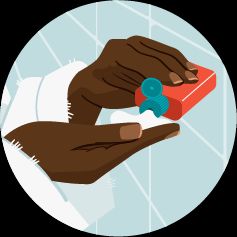Is there a difference between eczema and dermatitis?
Although the terms “dermatitis” and “eczema” may overlap in how they’re used, specific types of skin conditions are better known by just one of the names. For example, many doctors use the terms “atopic dermatitis” and “eczema” interchangeably but wouldn’t use the term “contact dermatitis” in place of “eczema.” Dermatitis means inflammation of the skin. Eczema is inflamed skin that has other symptoms like itching, a flaky or scaly rash, and dry skin. The table below compares the two conditions, with the bolded terms signifying differences.| Dermatitis | Eczema | |
|---|---|---|
| Type of Condition | Skin irritation | Skin inflammation |
| Acute or Chronic | Acute or chronic | Chronic |
| Cause(s) & Triggers | Allergens (including some medications) Irritants Autoimmune diseases Genetic conditions Stress Hormonal changes Hormonal dermatoses (a skin condition) Viruses Radiation Eczema | Allergens Irritants Immune-related Genetics Stress Dryness Fragrances Temperature changes Sweating Food allergies Rough or synthetic fabrics |
| Signs & Symptoms | RashDry skin Itching Swelling Blisters Stinging or burning skin Skin discoloration | Rash Severe itching Dry skin Flaky skin patches Small raised bumps with fluid Patches crusted with yellow discharge Soreness |
| Complications | Skin infections Open sores | Skin infections Sleep problems from increased night symptoms Increased itching caused by scratching Thickened skin patches Additional types of eczema |
| Risk Factors | Environment Allergies Asthma Family history of dermatitis Age Overall health | Asthma Hay fever or other allergies Family history of eczema |
| Treatments | Antihistamines to reduce allergies Remove irritants (like scented skincare products) Reduce stress Topical steroid creams or oral steroids Topical calcineurin inhibitors (Protopic or Elidel) Decrease the amount of time bathing or showering (especially using too-hot water) Using skin moisturizers daily Oral immunosuppressants Light therapy Biologics Oatmeal baths Avoiding triggers | Antihistamines to reduce allergies Remove irritants Reduce stress Topical steroid creams or oral steroids Topical calcineurin inhibitors (Protopic or Elidel) Decrease the amount of time bathing or showering (especially using too-hot water) Using skin moisturizers daily Oral immunosuppressants Light therapy Biologics Immunosuppressants Light therapy Cold compresses |
Types of eczema and dermatitis
There are a number of distinct types of eczema and dermatitis, and, to complicate matters, it’s possible to have more than one type at the same time. While eczema and dermatitis both typically cause redness and itching, some types also cause blistering and peeling.Atopic dermatitis or eczema
Atopic dermatitis is a chronic condition that requires symptom management. It’s characterized by an itchy, red rash that usually appears at joints in your body, like knees or elbows, and even around the neck. But it can occur anywhere on the body. This condition occurs in flare-ups or bouts, meaning that it gets worse and improves in irregular cycles. Symptoms include:- dry skin
- flaky or scaly patches
- itching
- sores that may weep
Contact dermatitis
Contact dermatitis occurs when your skin reacts to something it’s come in contact with. This can include bleach, soap, poison ivy, certain metals, or other irritants. The rash is typically red and may itch or burn. Symptoms include:- red rash
- itching
- burning
- stinging
- blisters with liquid
Seborrheic dermatitis
Seborrheic dermatitis commonly affects areas where hair grows or oils are produced. These are areas where sebum (oil) is secreted. This dermatitis has a scaly, dry appearance and may be caused by a reaction to the yeast in your skin. Symptoms include:- scaly patches
- dandruff
- red skin
- rash located in oily areas
Other types of eczema
There are several other types of eczema:- dyshidrotic eczema (also known as pompholyx eczema)
- nummular eczema (also known as discoid eczema)
- follicular eczema
- stasis dermatitis (also called asteatotic eczema, varicose eczema, or gravitational eczema)
- neurodermatitis
- asteatotic eczema (eczema cracquelée)
Dermatitis or eczema prevention
Most forms of dermatitis and eczema are chronic conditions. One exception is contact dermatitis. It can be prevented by finding and avoiding the irritant that caused the skin condition. It’s important to see a doctor for a proper diagnosis, then try to avoid triggers for your type of eczema or dermatitis (like gluten for dermatitis herpetiformis and allergens for contact dermatitis). Other forms of dermatitis can usually be avoided or managed with proper self-care, which includes the following:- Avoid long showers or baths, which can dry out the skin.
- Use moisturizers like oils, lotions, or creams.
- Avoid irritants that make your skin more susceptible to breakouts, like scented products.
- Don’t scrub your skin too hard.
- Use topical steroids to help with itching.
- Keep your fingernails short if you have a habit of scratching.
- Avoid stressful situations that may cause a flare-up.











